Ron Schali has property within Timberlake Ranch, a community of many residents that spans 7,000 acres of remote and rugged land across McKinley and Cibola Counties in the northwest part of New Mexico. The forests and mountains surrounding Timberlake Ranch inspire an appreciation of the natural world that Ron first gained while hiking the Sierra Nevada mountains of California. While exploring, Ron developed a passion for spending time outdoors and learning about forest ecology. He also experienced wildfire in all stages, seeing many burn scars and even active wildfires on numerous occasions. These experiences stuck with Ron, “if you have seen a wildfire, it is impressive how powerful those things are, it can make you feel pretty powerless when you see a fire going full speed ahead... it’s very scary.”
When he moved to New Mexico 16 years ago, Ron brought his interest in forest and fire ecology with him and became intrigued with the fire adapted forests surrounding Timberlake Ranch and the potential risk they posed to his community. As an Environmental Science teacher Ron was eager to learn more about his new home, and he became connected with community members of the ranch that shared his interest.
About a year ago, Ron and a group of neighbors, including FACNM Leader Mary Jo Wallen, began organizing what would become the Timberlake Fire Mitigation and Forest Health Committee. Ron described that one of the committee’s key goals was "to be educational and get more people involved in thinking about how we could improve their area by making it safer and healthier.” He feels strongly that “anybody who lives in the forest and sees the increase in wildfires and disasters that are happening can see that the time is right to try to encourage the whole community to start thinking about what to do.” Although addressing wildfire mitigation for the whole Timberlake community can be daunting for the committee at times, they have been making incremental progress by setting achievable, short-term goals.
Ron shared the useful insight that, “it’s a big project, you have to break it up to make it palatable for folks not to get overwhelmed. It makes it more likely to happen if you break it into smaller chunks.” This approach seems to be working for the committee, and in the last year they have taken some strong steps toward wildfire mitigation.
Using Community Wildfire Protection Plans (CWPPs) of nearby counties to document Timberlake’s wildfire risk, the committee was able to present their case to the Timberlake Land Owners Association (TRLA). The Fire Mitigation and Forest Health Committee is now formally recognized and has an opportunity to speak at each meeting, is included in budget discussions, and has gotten TRLA support for some key projects in their first year, including:
· Updating their emergency evacuation plans,
· Updating phone numbers and call lists for community members,
· Providing educational materials to homeowners,
· Thinning and reducing ladder fuels around 10 miles of roads, and
· A forest health plan for 600 acres..
In reflecting on the success of the Timberlake Fire Mitigation and Forest Health Committee, Ron shared some useful advice:
It is critical that you start with the “low-hanging fruit.”
Find projects that already have support and people on board and use those to build momentum toward areas that may be more challenging.
Show off your completed projects as educational tools to get others interested.
At the end of the day, the process of planning mitigation projects will strengthen your community by building connections along the way. Take your time and enjoy the process of getting to know your neighbors through these shared goals.



